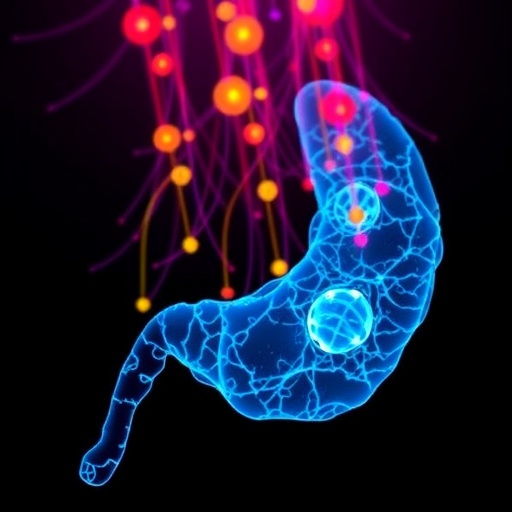Intrahepatic cholangiocarcinoma (ICC), a highly aggressive and heterogeneous liver cancer, continues to challenge clinicians and researchers due to its poor prognosis and complex metastatic behavior. Recent advances in single-cell multi-omics technology have opened unprecedented avenues to dissect the cellular heterogeneity and molecular underpinnings of numerous cancers. A groundbreaking study published in BMC Cancer in 2025 takes a deep dive into the metastatic mechanisms of ICC using cutting-edge single-cell RNA sequencing (scRNA-seq) coupled with sophisticated computational analyses. This work not only sheds light on the elusive cellular drivers of ICC metastasis but also proposes a novel prognostic tool with powerful clinical implications.
One of the study’s pivotal innovations lies in its ability to untangle the diverse cellular landscape of ICC tumors. Leveraging the publicly available GSE201425 single-cell RNA sequencing dataset, the researchers embarked on a comprehensive investigation to reveal the identity and trajectories of cells implicated in ICC metastasis. This approach allowed them to capture the complex interplay of tumor epithelial cells and their microenvironmental context, which classical bulk sequencing could easily mask due to cellular averaging effects. By focusing at the single-cell level, the team could isolate and characterize rare malignant subpopulations critical for cancer dissemination.
Employing copy number variation (CNV) profiling and clonal evolution analysis, the researchers identified a subset of malignant epithelial cells distinctively associated with metastatic ICC lesions. These cells exhibited unique genetic alterations indicative of aggressive oncogenic behavior. Pseudotime trajectory analysis further illuminated the dynamic progression of epithelial cells, pinpointing a specific population—termed metastasis-associated epithelial cells (MAECs)—that appears to act as key drivers of ICC metastasis. This detailed mapping of cell state transitions unveils the stepwise evolution through which ICC cells acquire metastatic competence.
The investigation didn’t halt at cellular identification. The study meticulously screened for biomarker candidates uniquely enriched in MAECs, identifying MMP7, FXYD2, and PTHLH as top candidates tightly linked to metastatic activity. Each of these molecules has known implications in cancer biology: MMP7 is a metalloproteinase involved in extracellular matrix remodeling, FXYD2 modulates ion transport and cellular homeostasis, and PTHLH (parathyroid hormone-like hormone) influences cell proliferation and migration. Their co-expression in MAECs forms a distinctive molecular fingerprint of metastatic potential.
To translate these insights into a clinically actionable framework, the researchers constructed a Metastasis Index (Met-Index) based on one-class logistic regression, integrating expression patterns of the identified biomarkers. Validation using bulk RNA-seq data from TCGA-CHOL revealed the Met-Index as a robust stratifier of patient risk. Patients exhibiting a high Met-Index faced significantly poorer overall survival and progression-free survival rates, underscoring the index’s prognostic value. This tool could empower clinicians to identify high-risk patients early and tailor aggressive treatment strategies accordingly.
Validation extended beyond computational models. Multiplex immunofluorescence staining of 34 clinical ICC specimens confirmed elevated expression of MMP7, FXYD2, and PTHLH in metastatic tumors compared to their non-metastatic counterparts. Importantly, elevated biomarker levels correlated with adverse clinicopathological parameters, reinforcing their relevance as indicators of metastatic aggressiveness. This multi-modal verification strengthens the credibility of these markers as both diagnostic and therapeutic targets.
Functional assays in the HuCCT1 cholangiocarcinoma cell line provided direct evidence of the biomarkers’ roles in tumor biology. siRNA-mediated silencing of MMP7, FXYD2, and PTHLH significantly curtailed cell proliferation while impeding migration capabilities, hallmark characteristics of metastatic phenotypes. These in vitro results spotlight these molecules as potential targets for therapeutically halting ICC progression, opening doors to novel drug development avenues.
This study’s approach epitomizes the power of integrative single-cell multi-omics in oncology. By combining genetic, transcriptional, and spatial data, the research constructs a holistic model of metastasis, moving beyond mere association toward mechanistic understanding. It also exemplifies how computational modeling and experimental validation can coalesce to produce clinically translatable outcomes that may revolutionize patient management protocols.
ICC has long been hampered by late diagnosis and scant prognostic biomarkers, leading to treatment failures and dismal survival rates. The revelation of MAECs and their defining molecular traits offers a targeted pathway for early intervention. Tailoring therapies to inhibit these metastasis-initiating cells could significantly curtail disease dissemination, ultimately improving patient prognosis and quality of life.
Moreover, the Met-Index developed here presents an elegant and statistically sound method for quantifying metastasis risk from existing bulk transcriptomic data, facilitating broader clinical deployment. This index could potentially be integrated into routine diagnostic pipelines, guiding patient stratification and personalized treatment decisions, particularly in settings where single-cell sequencing may not be readily available.
The study invites further exploration into how the tumor microenvironment interacts with MAECs, possibly influencing metastatic capabilities or therapeutic resistance. Additionally, translating these findings into in vivo models and clinical trials will be imperative for validating therapeutic targeting of MMP7, FXYD2, and PTHLH. Such future investigations could pave the way for innovative combination therapies that neutralize metastatic pathways in ICC.
In conclusion, this landmark investigation articulates a detailed map of ICC metastasis at an unprecedented resolution. The identification and characterization of MAECs as a discrete metastatic subpopulation, together with the novel Met-Index, represents a major leap forward in understanding and managing this formidable malignancy. This integrative research underscores the transformative potential of single-cell multi-omics approaches in oncology and sets a new standard for biomarker discovery and prognostic modeling.
As interest in precision oncology escalates, studies like this exemplify the synthesis of advanced technologies and computational prowess needed to combat complex cancers. The journey toward conquering ICC metastasis is far from over, but armed with these new molecular insights and diagnostic tools, the future offers hope for more effective management and improved survival of affected patients. The continued unraveling of cancer’s cellular heterogeneity will undeniably fuel the next generation of targeted therapies and prognostic innovations.
The oncology community awaits with anticipation how these findings will reshape ICC treatment paradigms and inspire similar multi-omics investigations across other challenging cancer types. This study is a testament to the power of collaborative, interdisciplinary science in decoding and defeating cancer’s most lethal traits.
Subject of Research: Intrahepatic cholangiocarcinoma (ICC) metastasis drivers and prognostic biomarkers
Article Title: Single-cell multi-omics analysis reveals drivers of intrahepatic cholangiocarcinoma metastasis
Article References:
Zhang, Z., Dou, H., Zhao, S. et al. Single-cell multi-omics analysis reveals drivers of intrahepatic cholangiocarcinoma metastasis. BMC Cancer (2025). https://doi.org/10.1186/s12885-025-15253-y
Image Credits: Scienmag.com
DOI: https://doi.org/10.1186/s12885-025-15253-y
Tags: BMC Cancer 2025 publicationcancer dissemination studiescellular heterogeneity in cancercopy number variation profilingICC metastasis mechanismsintrahepatic cholangiocarcinoma researchliver cancer prognosis insightsmalignant cell subpopulationsprognostic tools for liver cancersingle-cell multi-omicssingle-cell RNA sequencing technologytumor microenvironment analysis





